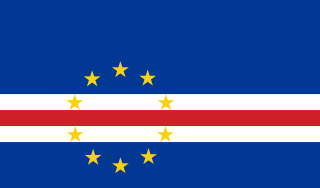
Cape Verde is known internationally for morna, a form of folk music usually sung in the Cape Verdean Creole, accompanied by clarinet, violin, guitar and cavaquinho. Funaná, Coladeira, Batuque and Cabo love are other musical forms.

Germano Almeida is a Cape Verdean author and lawyer.
The morna is a music and dance genre from Cape Verde.

Eugénio de Paula Tavares was a Cape Verdean poet. He is known through his famous poems (mornas), mostly written in the Creole of Brava.

Boa Vista, also written as Boavista, is a desert-like island that belongs to the Cape Verde Islands. At 631.1 km2 (243.7 sq mi), it is the third largest island of the Cape Verde archipelago.
Cape Verdean Creole is a Portuguese-based creole language spoken on the islands of Cape Verde. It is the native creole language of virtually all Cape Verdeans and is used as a second language by the Cape Verdean diaspora.
Boa Vista Creole is the name given to the variant of Cape Verdean Creole spoken mainly in the Boa Vista Island of Cape Verde. It belongs to the Barlavento Creoles branch. This form of Cape Verdean Creole was spoken by 5,000 ppl. in 2007 and is the least spoken form of Creole in the language. Literature is rarely recorded but one of the speakers who was born on the island is Germano Almeida.

Jorge Vera-Cruz Barbosa was a Cape Verdean poet and writer. He collaborated in various reviews and Portuguese and Cape Verdean journals. The publication of his poetry anthology Arquipélago (Archipelago) in 1935 marked the beginning of Cape Verdean poetry. He was, along with Baltazar Lopes da Silva and Manuel Lopes, one of the three founders of the literary journal Claridade ("Clarity") in 1936, which marked the beginning of modern Cape Verdean literature.
Adriano Gonçalves, known by his stage name Bana and called the "King of Morna", was a Cape Verdean singer and performer of the morna style, the plaintive, melodic lament which is a staple musical style of the country.

Fantcha is a Cape Verdean singer.
Tabanka is a musical genre of Cape Verdean music.
Maria Alice may also refer to a Portuguese fadista
Hernani Almeida is a Cape Verdean musician. In 1994 he formed his first rock band named what and has records and produced many albums. He was named Best Guitarist (2005) and Best Artist (2006) of the nation prize "Nos Musica" given to recognize Capeverdean artists.
Yara dos Santos is a Cape Verdean writer.
Dany Silva is a Cape Verdean singer, musician, composer and producer.

Nancy Vieira is a Cape Verdean singer who was born in Guinea-Bissau and currently resides in Portugal.
Gardénia Benrós is a Cape Verdean singer.
Maria Dulce de Oliveira Almada Duarte (1933–2019) was a Cape Verdean linguist who was a member and resistance fighter of the African Party for the Independence of Guinea and Cape Verde.

The Literature of Cape Verde is among the most important in West Africa, it is the second richest in West Africa after Mali and modern day Mauritania. It is also the richest in the Lusophone portion of Africa. Most works are written in Portuguese, but there are also works in Capeveredean Creole, French and notably English.

Colá is a musical genre of Cape Verdean music








